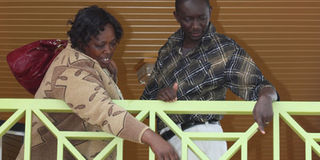Doctors puzzled by new facts in Wanjiru’s death

Photo/SULEIMAN MBATIAH
Wanjiru's mother, Ms Hannah Wanjiru and her lawyer Gordon Ogola on June 1, 2011 inspect the place from where her son allegedly fell from.
There were more questions than answers on Wednesday after the first post-mortem examination on marathon star Samuel Wanjiru.
Chief Government Pathologist Dr Moses Njue appeared to question claims that Wanjiru plunged to death from the balcony at his home.
He, however, declined to address journalists at the police station, with lawyers for the athlete and his mother later issuing contradicting statements.
Later at Wanjiru’s home, Dr Njue argued that the injuries to Wanjiru’s palms and knees indicated that the athlete landed on his fours and was conscious that he was jumping.
This could therefore not explain the fatal injury to the back of his head, which preliminary investigations indicated was inflicted by a “blunt force”.
“He landed on his legs and supported himself with his hands. Where did the injury on the back come from? We could turn into fools if we don’t ask ourselves this question,” Dr Njue said as he stood at the balcony.
They were at the house to measure the height of the balcony.

Photo/SULEIMAN MBATIAH/NATION
Government Pathologist Dr Moses Njue at Samuel Wanjiru's home on June 1, 2011.

Photo/SULEIMAN MBATIAH/NATION
Policemen and pathologists on June 1, 2011 take measurements at the scene where marathon champion Samuel Wanjiru fell.
One of the pathologists muttered that “this is not a simple matter” as they left the compound for the third long meeting at the police station.
Dr Njue appeared to be in deep thought, and disturbed, as he looked down the balcony and got the police to repeat their version of events on May 15.
The team put the height at 14 feet and stood at the scratched railing at the balcony where the athlete is said to have stood as he argued with his wife below.
Ms Terezah Njeri, the athlete’s wife, was questioned again over events on the fateful night.
One of the first men to arrive at the scene demonstrated the position in which he was found, with Ms Njeri standing nearby and her mother-in-law sitting a few metres away.
Police had also recalled Jane Nduta, the waitress who accompanied Mr Wanjiru home and whose presence there sparked the latest quarrel between the couple.
It also emerged that mortuary attendants at Nyahururu District Hospital began the embalming process before the body was transported to Lee Funeral Home.
Dr Emily Rogena, the pathologist appointed by the athlete’s mother, asked why the attendants were in a hurry to embalm the body as it could interfere with body fluid, making it difficult to establish the exact cause of death.
This forced the team of lawyers, relatives, doctors and police into an hour-long meeting before heading to the home.
Investigations have been complicated by the fact that the scene was not secured and the closed-circuit television security system was not fully functional.
Lawyers for the athlete’s mother demanded that the investigation be taken up by a higher office, saying performance of the police in Nyahururu was unsatisfactory.
“It has now emerged that the fatal injury could not have been sustained as a result of a fall,” said Mr Gordon Ogolla.
“There is definitely something that is not being said. What we have seen here is that no investigation has been done. They merely recorded statements from the witnesses and took them as gospel truth,” said Mr Ogolla.
Ndegwa Wahome, who represents Ms Njeri, said the doctors would require more time to make conclusive findings on the cause of the athlete’s death.
“Everybody in this matter would want to see justice being done. The preliminary findings by the doctor is that the cause of death was a force on the head which is keeping with a fall from a height,” said Mr Wahome.
The civil suit filed by the athlete’s mother to stop the burial and have a post-mortem conducted comes before the High Court in Nakuru on Thursday.




